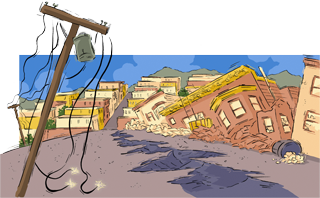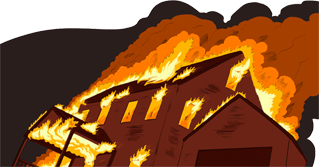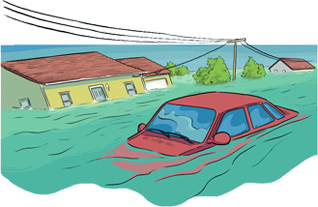
Earthquakes are the shaking, rolling or sudden shock of the earth’s surface. Earthquakes happen along cracks (called fault lines) in the earth's surface. Earthquakes can be felt over large areas, although they usually last less than one minute. Earthquakes cannot be predicted — although scientists are working on it!
Visit the FEMA library to download more facts about Earthquakes
Before
- Build an emergency kit.
- Make a family communications plan.
- Know the safe spots in every room – under a sturdy table or against an inside wall.
- Ask your family to hold earthquake drills – drop, cover, and hold on!
During
- DROP to the ground.
- Take COVER under a sturdy table or other heavy furniture. If there is nothing to get under, cover your face and head with your arms and crouch near an inside wall.
- HOLD ON until the shaking stops.
- STAY AWAY from windows, glass, lighting fixtures, or furniture that could fall – like bookcases.
- STAY INSIDE!
- Do not use elevators!
- Stay there.
- Move away from buildings, streetlights, and wires.
- Stay out in the open until the shaking stops. Buildings could collapse and hurt you.
- Cover your mouth with your shirt.
- Do not scream – you could breathe in dust.
- Tap on a pipe or wall so rescuers can find you.
After
- Expect aftershocks. They are usually not as strong but can cause damage.
- Open cabinets carefully. Objects that have moved could fall on you.
- Wear long pants, long sleeves and shoes to protect your skin from getting scratched by broken objects.
- Text, don’t talk. Unless there’s a life-threatening situation, if you have a cell phone, send a text so that you don’t tie up phone lines needed by emergency workers. Plus, texting may work even if cell service is down.
Home Fires

Each year more than 2,500 people die and 12,600 are injured in home fires in the United States. But unlike other disasters, home fires can be prevented! It's important to know this: Fire is fast! There is no time to gather anything or make a phone call. In just two minutes, a fire could kill you. In five minutes, a house could be swallowed in flames.
Fire is hot! Heat and smoke could be even more dangerous than the flames. Breathing in really hot air could burn your lungs, and fire produces poisonous gases that can make you sleepy and unable to escape. Fire is dark! It can be hard to find your way out of your house in a fire. Fire is deadly! Fire uses up oxygen you need to breathe and produces smoke and poisonous gases that kill.
Visit the FEMA library to download more facts about Home Fires
Before
Create a fire escape plan and practice it twice a year
- Have smoke alarms in every bedroom and every floor of the house.
- Remind your parents to test the smoke alarms in your house every month.
- Find two ways to get out of each room. A window might be a second way if the door is blocked by fire or smoke.
- Practice feeling your way out of the house in the dark or with your eyes closed.
- Sleep with your door closed. It helps prevent fires from spreading quickly.
During
- Get low and go! Crawl under smoke to an exit. Heavy smoke and deadly gases collect along the ceiling.
- If you hear a smoke alarm, get out fast! You may only have a few seconds to escape.
- If smoke is blocking the door, use your second way out of the room or house.
- Feel the doorknob and door before opening it. If either is hot, leave the door closed and use the second way out.
- If you see smoke coming around the door, use the second way out.
- If you do open a door, open it slowly and be ready to shut it quick if there’s smoke.
- Don’t hide from firefighters! They may look scary with all of their equipment, but they are there to help you.
- Tell firefighters if there are any pets trapped in the house. Don’t try to get them yourself!
- If your clothes catch on fire, stop-drop-and roll! Stop, drop to the ground and cover your face with your hands. Then roll over and over or back and forth until the fire is out.
After
- Don’t go back into any building unless a firefighter or your parents say it is safe.
Floods

Flooding happens during heavy rains, when rivers overflow, when ocean waves come onshore, when snow melts too fast, or when dams or levees break. This is the most common natural-weather event. Flooding may be only a few inches of water or it may cover a house to the rooftop. Floods that happen very quickly are called flash floods.
Visit the FEMA library to learn more about floods
Before
- Build an emergency kit.
- Make a family communications plan.
- Tell an adult if you hear a flood warning on the TV or radio.
During
- Listen to authorities and safety officials.
- If there is any possibility of a flash flood, move immediately to higher ground.
- Help your family move important items to an upper floor.
- Do not walk through moving water. Even 6” of water can make you fall.
After
- Stay away from flood water. It could be contaminated, meaning contain dangerous substances.
- Stay away from moving water. It can knock you off your feet.
- Stay out of the way of emergency workers so they can do their job easily.

